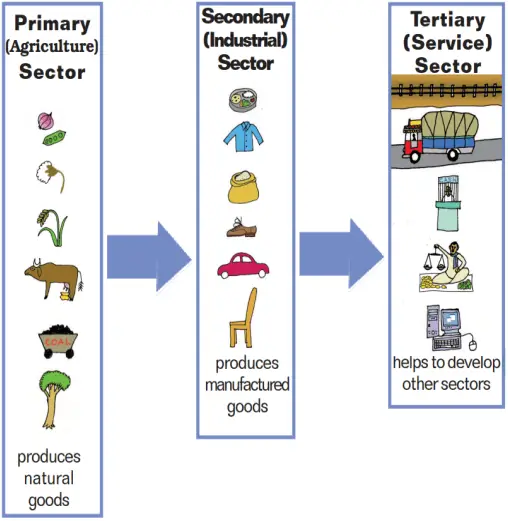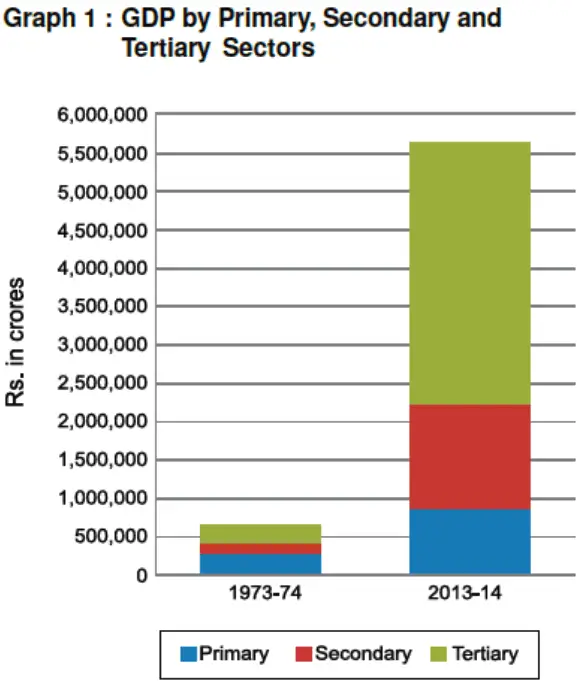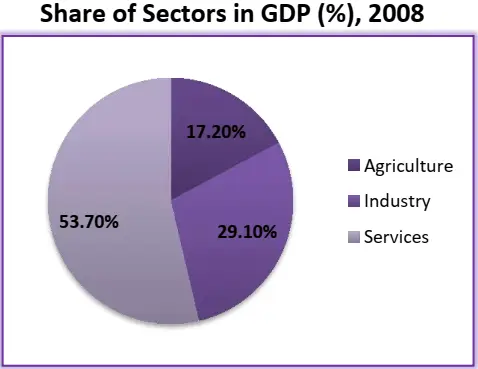Revision Notes for Class 10 Economics – Chapter 2 Sectors of the Indian Economy
Are you confused on Revision Notes? Revision Notes for class 10 Economics – Chapter 2 Sectors of the Indian Economy is the right place to refer.
Economic Activities
Economic activities are performed by three different sectors. They are the primary, secondary and tertiary sectors.
The primary sector is involved in natural products which we get from agriculture, fishing, dairy and forestry. When these natural products are converted to other forms of production through an industrial activity, it is known as the secondary sector. The tertiary sector provides services for the production of goods in the primary and secondary sectors. There are also certain important services such as teaching, medicine, law and information technology which may not directly help in the production of goods.
Primary sector: When we produce goods by exploiting natural resources, it is an activity of the primary sector. Eg: Farming, forestry, hunting, fishing and mining.
Secondary sector: Covers activities in which natural products are changed into other forms through ways of manufacturing, it is also called as industrial sector. For example, using cotton fibre from the plant, we spin yarn and weave cloth. Using sugarcane as raw material, we make sugar or gur.
Tertiary sector: These are the activities that help in the development of the primary & secondary sector. These activities by themselves do not produce good but they are an aid and support to the production process. Example: Transportation-Goods that are produced in the primary sector need to be transported by trucks or trains and than sold in the wholesale and retail shops; Storage-at times it is necessary to store these products in godowns, which is also a service made available. Communication – talking to others on telephone; Banking-borrowing money from the banks. Since these activities are generate services rather than goods it is also called Service sector.
Comparing The Three Sectors
In an economy, there could be one or more sectors which are dominant in terms of total production and employment, while other sectors are relatively small in size. Therefore, Comparison can be done among these three sectors on the basis of value of final goods and services produced.
The value of final goods and services produced in each sector during a particular year provides the total production of the sector for that year and the sum of production in these sectors gives us gross domestic product (GDP) of a country.
Historical Change in Sectors: The importance of sectors has changed, At the initial stages of development, primary sector was the most important sector of economic activity but over a period of time Secondary sector gradually became the most important in total production and employment. But there has been a further shift from secondary to tertiary sector in developed countries. The service sector has become the most important in terms of total production.
In the year 2013-14, the tertiary sector emerged as the largest producing sector in India, replacing the primary sector. The tertiary sector has become important in India because of the following reasons:
- Services such as hospitals, educational institutions, post and telegraph services, police stations, courts, village administrative offices, municipal corporations, defence, transport, banks, insurance companies, etc. are considered as basic services and are necessary for all people.
- The development of agriculture and industry leads to the development of services such as transport, trade, storage, etc.
- With the rise in the income of people, they start demanding more services like eating out, tourism, shopping, private hospitals, private schools, professional training, etc.
- Over the past decade, certain new services based on information and communication technology have become important and essential.
Value of Goods and Services
Only the final value of goods and services are counted because the value of final goods includes the value of all the intermediate goods which are used in producing the final good.
Gross Domestic Product
The gross domestic product (GDP) is the value of all final goods and services produced within a country during a particular year.
Historical Change in Sectors
Agricultural production was the predominant activity in the initial stage of development. Most of the people were employed in the primary sector. With the advancement in manufacturing, the secondary sector began to increase the total production and employment level. Gradually, the concentration of technological changes improved the efficiency of production in the tertiary sector.
Primary, Secondary and Tertiary Sectors in India
Over the years, there has been a massive growth in the turnover of all sectors of the economy. Therefore, the tertiary sector has been considered one of the largest producing sectors in India.
Importance of the Tertiary Sector
• Basic services such as education, health, postal communication, transport and banks are essential in daily life.
• The development of the primary and secondary sectors has improved the growth of the service sector.
• Because of an increase in the income level, people demand services such as tourism, shopping and dining.
• Recently, the services of advanced information and communication have gained more importance.
Employment Status
The share of the agricultural sector has substantially decreased, and the share of the tertiary sector has grown tremendously. However, the share of employment in these sectors was not in tune with the GDP, and still the agricultural sector is the largest employer. It means that there are more people employed in the agricultural sector than actually required. Even if few agricultural workers stop working, it does not affect the production level. This is known as disguised employment.
Creation of Employment
- National Rural Employment Guarantee Act, 2005 (NREGA, 2005) is implemented by the Central Government for guaranteeing 100 days of employment in a year.
- The Government provides money or banks provide loans to farmers to construct wells for irrigation of land.
- Under-employment in rural areas can be tackled by creating job opportunities where youth are employed in the construction of dams or in the digging of canals.
- Farming co-operatives need to provide cheap credit to farmers for improving farming.
- Identify and locate job opportunities in industries and services in semi-rural areas.
- Strengthen the functions of education and health industries.
- Proper planning and support from the Government to facilitate services such as IT and tourism.
Division of Sectors as Organised and Unorganised
Organised Sector
The organised sector includes enterprises or places of work where the terms of employment are regular and work is assured. Companies are compelled to follow the rules and regulations passed under registered acts such as the Factories Act, Minimum Wages Act, Payment of Gratuity Act, and Shops and Establishments Act. Workers enjoy the security of employment and are expected to work only for a fixed number of hours. Over time hours are paid by the employer, and employees receive several other benefits.
Unorganised Sector
The unorganised sector is small and has scattered units which are mostly out of government control. Jobs are usually with low wages and are often not regular. An employee’s job is not secured and there are no provisions for perks and benefits.
- A farmer needs support through adequate facilities for timely delivery of seeds, agricultural inputs, credit, storage facilities and marketing outlets.
- Small-scale industries require the government’s support for procuring raw material and marketing of output.
- The casual worker needs protection in rural and urban areas.
Difference between Organised sector and Unorganised Sector
| Organised sector | Unorganised sector |
|---|---|
| It is a sector where the employment terms are fixed and regular, and the employees get assured work. | The unorganised sector is characterised by small and scattered units, which are largely outside the control of the government. |
| The job is regular and has fixed working hours. If people work more, they get paid for the overtime by the employer. | Jobs are low-paid and often not regular. |
| Workers enjoy the security of employment. | Employment is not secure. People can be asked to leave without any reason. |
| Employes will get medical and several other benefits. | No benefits are available for the workers. |
| Examples: Government employees, registered industrial workers, etc. | Examples: Shopkeeping, Farming, Domestic works, etc. |
Sectors in Term of Ownership: Public and Private Sectors
On the basis of who owns the assets and is accountable for the delivery of services, economic activities can be classified into public and private sectors.
Public Sector
In the public sector, the Government owns most assets and provides services to the public. Earning profit is not the motive. Some activities which involve large investment can be undertaken only by the Government such as constructing roads, bridges, railways; generating electricity; building ration shops; and providing facilities for health and education. In these activities, the Government has to support and ensure for everyone.
Private Sector
In the private sector, the ownership of assets and delivery of services are with individuals or private companies. Earning profit is the main motive. All services provided are to earn revenue.
Difference between Public Sector and Private Sector
| Public Sector | Private Sector |
|---|---|
| This sector is controlled and managed by the government. | This sector is owned by a private individual. |
| The purpose of the public sector is not just to earn profits. | Activities in the private sector are guided by the motive to earn profits. |
| This sector focuses on serving the general people of the country i.e. public welfare. | This sector focuses on constructing a brand image. |
| Capital is obtained by public revenue such as taxes, bonds, other duties and many more. | Capital can be obtained by issuing shares or loans in this sector. |
| Extremely secured employment by parameters of merit, progress or term of working. | This doesn’t ensure security of employment, totally based on merit and production output. |
| Highly secured job, multiple retirement facilities etc. | It doesn’t give any retirement benefit or allowances. |
| Jobs under this sector: Railways, Post office, Armed forces, Education etc. | Jobs under this sector: Tata Iron and Steel Company Limited, Reliance, IT sector etc. |
Responsibilities of Government
There are a large number of activities which are the primary responsibility of the government. Here, we have listed a few of them:
- Government raises money through taxes and other ways to meet expenses on the services rendered by it.
- Governments have to undertake heavy spending such as the construction of roads, bridges, railways, harbours, generating electricity, providing irrigation through dams, etc. Also, it has to ensure that these facilities are available for everyone.
- There are some activities, which the government has to support to encourage the private sector to continue their production or business.
- The government in India buys wheat and rice from farmers at a ‘fair price’ and sells at a lower price to consumers through ration shops. In this way, it supports both farmers and consumers.
- Running proper schools and providing quality education, health and education facilities for all are some of the duties of the government.
- Government also needs to pay attention to aspects of human development such as availability of safe drinking water, housing facilities for the poor and food and nutrition, taking care of the poorest and most ignored regions of the country.







